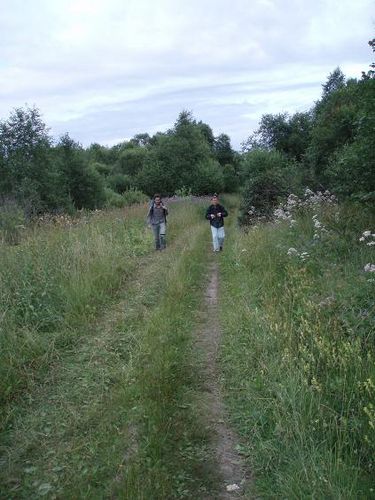 Northern
Thebaid. Part 1
Northern
Thebaid. Part 1Russian Orthodox Autonomous
Church
Back
to main pictures page
 Northern
Thebaid. Part 1
Northern
Thebaid. Part 1
"And still the voice of the Northern Thebaid calls us," Father Seraphim (Rose) wrote in his book of lives of the saints of Northern Russia, "-not, it may be, to go to the desert (although some fortunate few may be able to do even that, for the forests are still on God's earth)-but at least to keep alive the fragrance of the desert in our hearts: to dwell in mind and heart with these angelic men and women and have them as our truest friends, conversing with them in prayer; to be always aloof from the attachments and passions of this life, even when they center about some institution or leader of the church organization; to be first of all a citizen of the Heavenly Jerusalem, the City on high towards which all our Christian labors are directed, and only secondary a member of this world below which perishes. He who has once sensed this fragrance of the desert, with its exhilarating freedom in Christ and its sober constancy in Struggle, will never be satisfied with anything in this world, but can only cry out with the Apostle and Theologian: Come, Lord Jesus. Even so, Surely I come quickly (Apocalypse 22:20)."
The area of the Northern Thebaid is one night by train from St.-Petersburg. This place is loved my many Orthodox people who live or come to St.-Petersburg. In June 2006 three men from ROAC traveled there. They visited not only the "civilized" areas there but also some desolates and ruined monasteries with the holy relics of the saints.
They gave me some pictures for my web site, so I will place them here with the story in English. Here are two of these men. Dmitry Birjukov (left) is an altar-servicer in ROAC parish of St.Elizabeth in St.Petersburg. He works as an editor in the Publishing House of St.-Petersburg University and he finishes his PhD thesis (something about St.Gregory Nazianzen and Emperor Julian). Pavel Rudnev (right) is from Chelyabinsk. He is very gifted in languages, he knows or learn about two dozens of them, including several ancient ones. Besides he sings very well (he made our choir sound really beautiful), he is a good altar-servicer and reader.
They got a detailed map of the region before their trip, and it was a big help...
The train comes to the city of Vologda. This city was first mentioned in chronicles in 1147. In 15-17th centuries it was an important center of Russia, until St.Petersburg was founded by Peter the Great in 1703. On this picture you can see the Kremlin of Vologda with Sophia Cathedral (16th cent). Vologda is very nice, but the main aim of the trip is not the city...
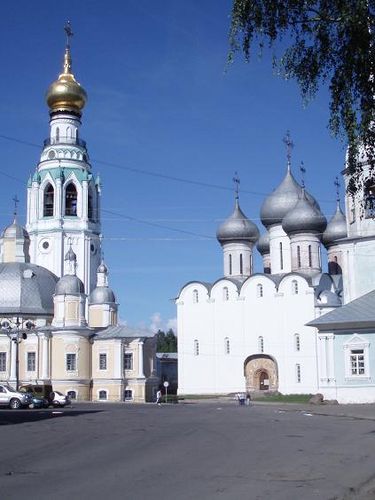
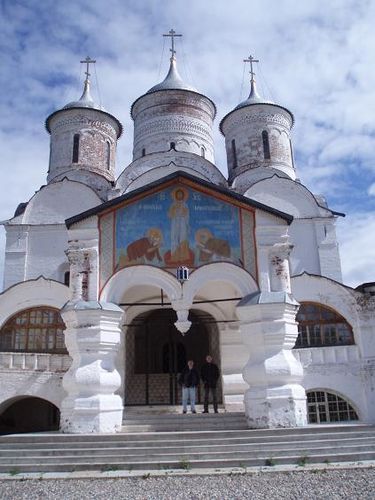 They
went at first to the monastery of St Dimitry of Priluki. St Dimitry was from
a rich family from Pereslavl, he entered monastic life as a youth. He was a
friend and disciple of St Sergius of Radonezh and he was very much respected.
Father Dimitry was trying to hide form fame and went to the north of Russia.
He founded a monastery near Vologda on the shores of Lake Priluki, whose rule
followed that of the Lavra of St Sergius. The Monastery did not have even the
wooden walls and the brethren was prohibited to beg. They prayed and worked
there, and the place became the spiritual center of the region.
They
went at first to the monastery of St Dimitry of Priluki. St Dimitry was from
a rich family from Pereslavl, he entered monastic life as a youth. He was a
friend and disciple of St Sergius of Radonezh and he was very much respected.
Father Dimitry was trying to hide form fame and went to the north of Russia.
He founded a monastery near Vologda on the shores of Lake Priluki, whose rule
followed that of the Lavra of St Sergius. The Monastery did not have even the
wooden walls and the brethren was prohibited to beg. They prayed and worked
there, and the place became the spiritual center of the region.
St Dimitry, who was exceptionally handsome, always concealed his face behind his monastic veil and never conversed with women. Once a noblewoman, driven by curiosity, managed to catch sight of his face in church. She immediately fell paralyzed to the ground. The Saint asked her 'My child, why did you want to gaze at the face of a sinner who has long been dead to the world?' He then gave her some words of instruction in the spiritual life and sent her away healed.
St Dimitry kept a constant fast, living only on prosphora and water. In his own lifetime the Saint was known for his gift of prophecy, his care for the poor, and his healings. Once his brother sought his blessing to trade with the pagans in the far north. He made a good profit there and asked for a blessing to return. This time the Saint would not give his blessing, but his brother went anyway, and was killed by pagans.
Toward the end of his life St Dimitry withdrew into solitude in his cell. He reposed on February 11, 1392. The brethren noticed a wonderful aroma of incense coming from his cell and knew that he had departed this life for heaven. After his repose he continued to work countless miracles, healing illnesses (especially the plague), and driving away invaders.
Many new buildings were built in his monastery after his death. This is the main cathedral where there are the relics of St Dimitry and St Ignaty. St Ignaty (Ioann) was at first prince of Uglich. He was imprisoned in this monastery in the 15th century by his uncle Prince Basil III. He was only 13 years old when he got there. He lived as a pious hermit here and died at the age of 45 as a monk. His relics became venerated after his death.
As far as the monastery is near Vologda it was preserved well in Soviet times (it was used for some needs of Vologda), and Moscow Partiarchate got it. The head of the monastery Father Dionysi is a very good person and he knows and loves the saints of his region. May God help and guide him.
Here are Pavel and Dimtiry Shabanov after singing "We magnify..." to St Dimitry and St Ignaty at the walls of the monastery. Dimitry Shabanov is our choir director and churchwarden and a remarkable person. He is very educated in canons, church history, theology, etc. He had graduated the Seminary of MP with honours and was studying in the Theological Academy when he realized that MP had deflected from Orthodoxy. Now he is in ROAC, he is a student in the department of Philosophy at St.-Petersburg University.
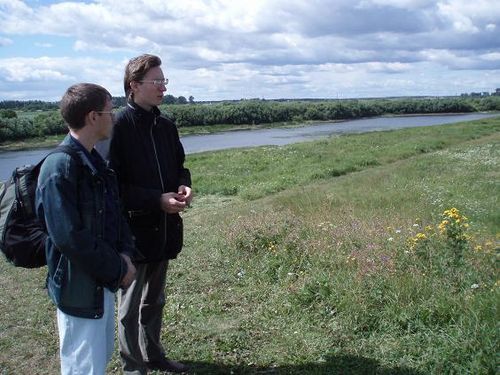
They had some rest before going to the wilderness.
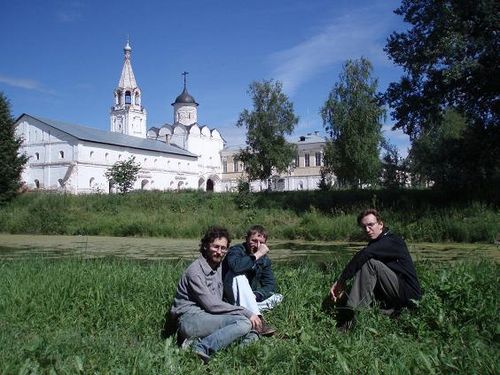
They hitch-hiked along the road towards Arkhangelsk and then turned to the forest road. Their next point was the monastery of St.Gregory of Pelshma...
 St.Gregory
was born in 1440th into a powerful boyar family in the sity of Galich. Early
in life he was drawn to the ascetical life, and was distressed when his parents
arranged for him to be married at the age of only fifteen. By a mysterious providence,
both his parents died before the wedding could be held, and St Gregory very
soon distributed his considerable wealth to the poor, freed all his serfs, and
went to the nearest monastery. Such was his holiness of life that he rose to
be abbot of the monastery, but as in his youth he felt burdened by the admiration
and attention of men, so he left for the monastery of St Dionysius of Glushitsa,
where he strove to live a hidden life.
St.Gregory
was born in 1440th into a powerful boyar family in the sity of Galich. Early
in life he was drawn to the ascetical life, and was distressed when his parents
arranged for him to be married at the age of only fifteen. By a mysterious providence,
both his parents died before the wedding could be held, and St Gregory very
soon distributed his considerable wealth to the poor, freed all his serfs, and
went to the nearest monastery. Such was his holiness of life that he rose to
be abbot of the monastery, but as in his youth he felt burdened by the admiration
and attention of men, so he left for the monastery of St Dionysius of Glushitsa,
where he strove to live a hidden life.
His spiritual father, St Dionysius, discerned Gregory's gifts and wanted him to found his own monastery, but the Saint resisted, desiring only to live in humility and obedience, unknown to the world. With his elder's blessing, St Gregory went to live as a hermit in a small cell on the banks of the River Pelshma. After a few years other monks came to live the hesychastic life with him and, as his spiritual father had desired, Gregory against his will became the abbot of a new monastery.
Hegumen Gregory excelled not only in prayer but in his works of love for the poor, many of whom came to him in times of famine, when he would give them the small reserves of the monastery. More than once he traveled to Moscow to rebuke the Princes for their evil deeds. One of these, Prince Dmitry Shemyaka, was so angered by the 'presumption' of the Saint that he had him thrown from a bridge into a deep gorge, so that the old monk was almost dead for several hours there. After that Dmitry Shemyaka ceased to offend the city of Vologda.
St Gregory felt his end approaching and prepared himself. He told his disciples to throw his body into a swamp when he died (as St Nilus of Sora asked about his own body), but after his repose they disobeyed and gave him honorable burial. A beautiful fragrance filled the church and, for the first time, a miracle of healing was performed through the Saint's relics, which from that time forward were the source of countless wonders..
The road there was going through the forest for a long time. Finally they saw a village that was on the map, but the village was almost completely destroyed. There were very few people living there now.



They kept on going and going and going. They almost lost the hope to find the monastery. But suddenly they saw some buildings in the forest.
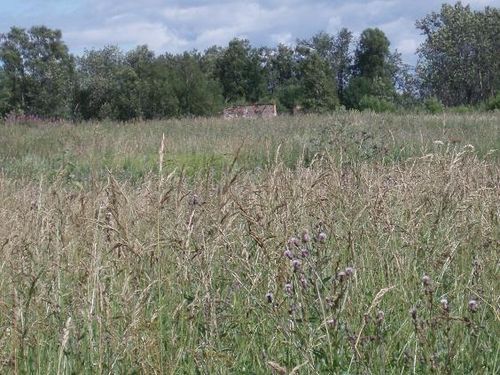
When they came closer they realized those were the ruins of the monastery they were looking for.
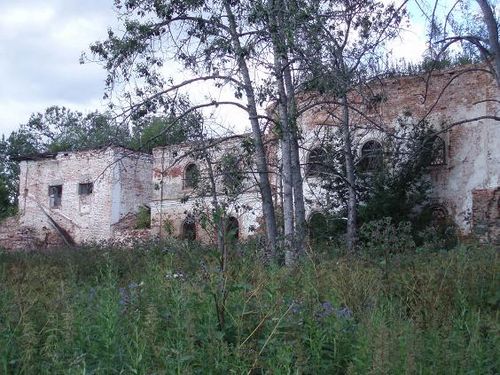
First of all they went to church.

The founder of this monastery St Gregory Pelshemsky lived in the 15th century. His monastery was wooden, and the stone buildings were built much later. But the place is blessed by his prayers and the prayers of the monks that lived there.
His relics are in the wall of the altar here (where the icon is). It is clear that somebody comes here to pray sometimes.
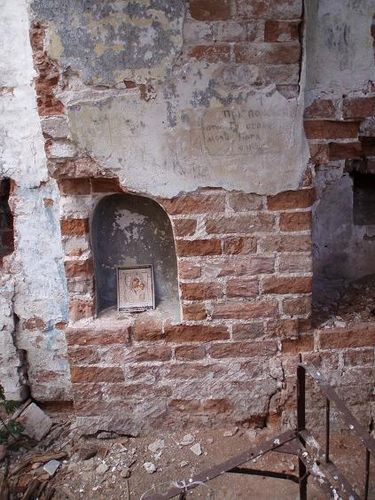
This is how the altar looks from the wall --

This is how the building with the cells looks from inside --
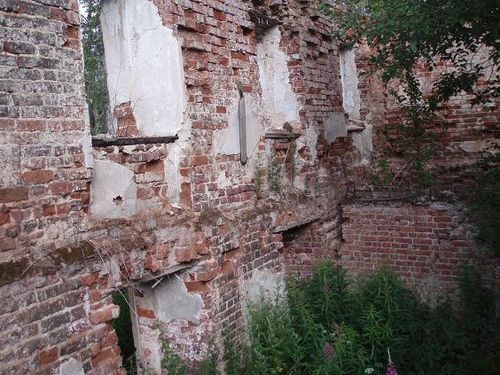
And here is trapeznaya (the place where monks eat) --
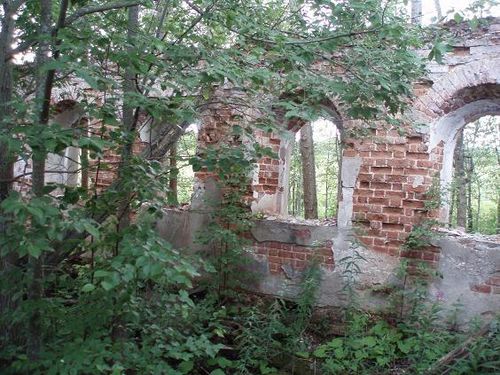
It seems like there was a church at trapeznaya too -- the building ends with some octagon that looks like a church --
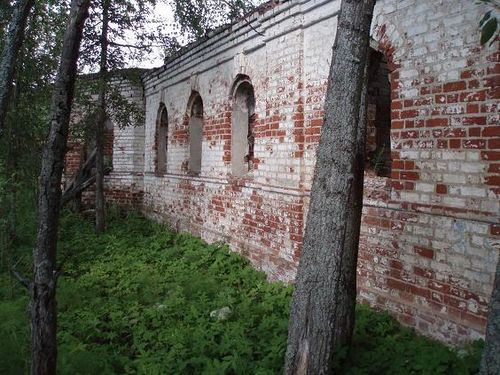
There was the fourth building in the monastery too, but its purpose was unclear --
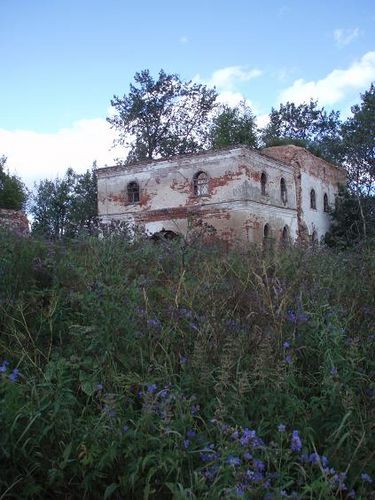
It seems like it had cells inside too --
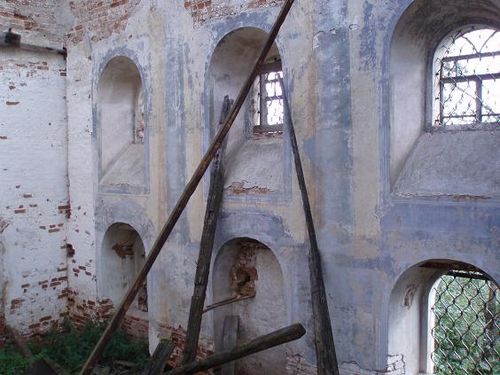
And somebody tried to divide it into two parts later --

Here is the window there that is almost OK.


The view from the bridge, that is also destroyed. The bridge leaded to the village on another bank of the river. This village does not exist anymore, although it is still on the map and it had people and a school only 30 years ago..
They left the monastery when the sun was going down. They were very tired, and a long way back to Vologda was waiting for them. But suddenly they saw a tractor in the high grass. It was some man that was born on the ruined village near the monastery. He left that place a long time ago, but he keeps on visiting that village and a monastery once in two years. So he came there right the day when they needed him.
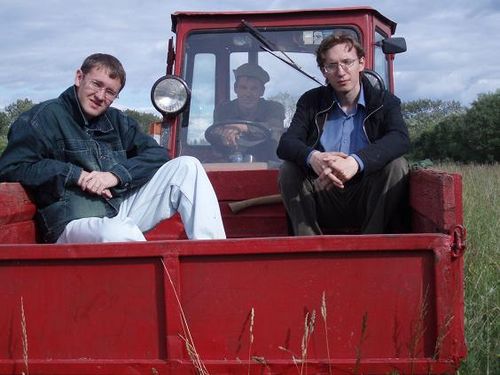
So he gave them a lift and they returned to Vologda before night.
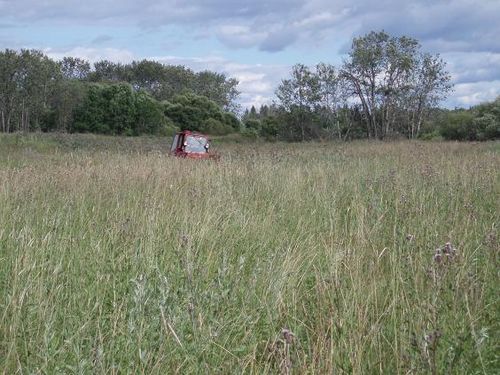
TO BE CONTINUED!
Some parts of the lives of the saints in English I took from here.